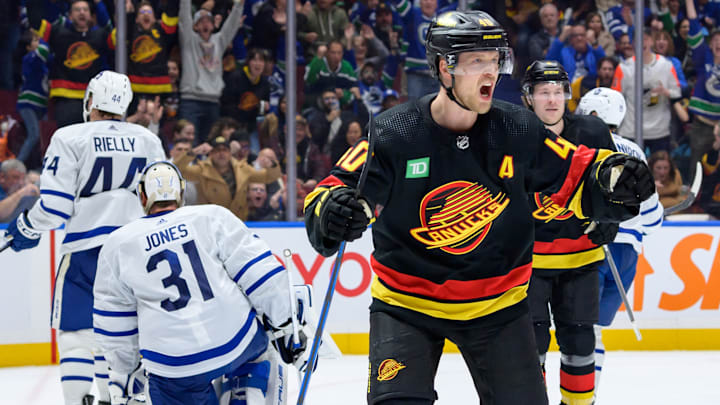At the start of the season, the Vancouver Canucks' first power play unit was considered nuclear. Currently, it sits in a 1-28 abyss. Has it been defused, or is it still armed and dangerous?
The secret to the Canucks' early success this year wasn't much of a secret at all; It was the growth of Quinn Hughes's game. Immediately, it was obvious that he leveled up dramatically as he controlled games and dictated outcomes. This was no less the case in the power play, where he danced like never before.
Quinn was walking the line better than any player in hockey, opening up lanes for himself to shoot. He took advantage and shot the puck far more often than in previous seasons. This was a big talking point in pre-season, so it was by design. Hughes also began to skate down the left wall and often snapped his improved shot to the far side successfully. He's still dancing most nights, still waiting for the results.
Opposition penalty killers have adapted to Hughes’ tendencies, recognizing his importance; they are keying in on him. PP1 has been significantly impacted since Quinn, the main distributor, lost his advantage. Hughes has been forced to defer to his flanks, reducing the power play to passing the puck around the perimeter until they get frustrated and give it away. With PKs wise to the Canucks, it’s time to adjust back.
In today's NHL, you must be creative and quickly adapt. You also can be bold and think outside the box. Most teams already go with one defenseman on their top unit power plays. Would it be so crazy to move Quinn off the point? The captain is still just as dynamic after all; he needs a new route to the net.
Moving Hughes to the right half-wall potentially accomplishes several things for Vancouver’s power play. For starters, it pushes Elias Pettersson, in this scenario, to the bumper, a position he has rarely if ever, occupied. Petey has struggled with puck handling on the power play, trying to force passes through skates, leading to clears, turnovers, and even a concerning amount of short-handed goals. The bumper must get a shot off your stick the moment it arrives and get it on target. Pettersson possesses a laser beam that fits here perfectly.
With Elias Lindholm at the netfront, Brock Boeser is set up on his one-timer side, which leaves JT Miller manning the point. Miller is an exceptional passer and brilliant at finding teammates in prime scoring areas, but JT also might possess the best shot on his team. While Pettersson’s one-timer from the wall is more of a decoy than an actual weapon, Miller's wrister, when skating downhill, is lethal. He’d be primed to facilitate and get his deadly shot off more often from this position.
Quinn Hughes had success when he focused on shooting more and from closer to the net, which paid off in spades. He reached his career high in goals when he potted his ninth in Game 25 at Calgary, but in the following 34 games, he has managed just three.
Placing Hughes on the right half-wall means he’s already much closer to the net when he receives the puck and on his strong shooting side. He could no doubt find new ways to facilitate from here but also to drive the middle of the ice, not to mention the net, with the puck and create all sorts of havoc down low.
Unless you're satisfied watching Filip Hronek shoot pucks into awaiting shin pads more often than Alex Edler, reverting to two D-men, as they tried again unsuccessfully on Thursday in Seattle, isn’t the answer.
The Canucks have a very interesting and unusual approach with Rick Tocchet himself running PP1 and without many set plays. Clearly, the thinking is to let these very talented players work their magic. Sometimes even the stars need a reset, a different perspective. Maybe Toc needs to follow his own advice and “learn to play uncomfortable” with his top power play unit.
